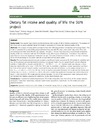Identificador persistente para citar o vincular este elemento:
https://accedacris.ulpgc.es/jspui/handle/10553/19010
| Título: | Dietary fat intake and quality of life: the SUN project | Autores/as: | Ruano-Rodríguez, Cristina Henríquez Sánchez, Patricia Bes-Rastrollo, Maira Ruiz-Canela, Miguel López del Burgo, Cristina Sánchez-Villegas, Almudena |
Clasificación UNESCO: | 3206 Ciencias de la nutrición | Palabras clave: | Dynamic cohor Fatty acids intake SF-36 Health Survey Mental quality of life Physical quality of life |
Fecha de publicación: | 2011 | Proyectos: | Papel de la Ingestión de Ácidos Grasos Omega-3 y de la Actividad Física en la Prevención de la Depresión Papel de la Dieta y la Actividad Física Sobre la Calidad de Vida y la Enfermedad Mental en El Estudio Sun Red Alimentación Saludable en la Prevención Primaria de Enfermedades Crónicas: la Red Predimed. (Retics 2006) Encomienda del Rector de la Universidad de las Palmas de Gran Canaria A la Fundación Canaria Parque Científico Tecnológico de la Universidad de las Palmas de Gran Canaria Para la Gestión del Iuibs |
Publicación seriada: | Nutrition Journal | Resumen: | Background: Few studies have related nutritional factors with quality of life in healthy populations. The purpose of the study was to assess whether dietary fat intake is associated to mental and physical quality of life. Methods. This analysis included 8,430 participants from the SUN (Seguimiento Universidad de Navarra) Project. The intake of saturated fatty acids (SFA), polyunsaturated fatty acids (PUFA), trans unsaturated fatty acids (TFA), and monounsaturated fatty acids (MUFA) was assessed through a 136-item food frequency questionnaire at baseline. Quality of life was measured with the SF-36 Health Survey after 4 years of follow-up. Generalized Linear Models were fitted to assess the regression coefficients (b) and their 95% confidence intervals (95% CI) for the 8 domains of the SF-36 according to successive quintiles of each kind of fatty acids intake. Results: The multivariate-adjusted models revealed a significant inverse association for SFA intake (in quintiles) and two of the physical domains (physical functioning and general health). E.g. for general health domain: (highest quintile of intake (Q5) vs. lowest quintile (Q1), b = -1.6; 95% CI = -3.1, -0.1. General health also showed a dose-response relationship (p for trend < 0.05). For TFA intake (in quintiles), a significant inverse association was found for most of the mental domains (vitality, social functioning and role emotional). E.g. for vitality domain (Q5) vs. (Q1), b = -2.0, 95% CI = -3.4 to -0.6. We also found an inverse association between TFA intake and the bodily pain domain: (Q5 vs. Q1), b = -2.6; 95% CI = -4.4 to -0.8, with a statistically significant dose-response relationship (p for trend < 0.05). Except for TFA intake and the mental domains, the rest of the associations were attenuated when we repeated the analysis adjusting for adherence to the Mediterranean diet. Conclusions: A detrimental relationship between TFA intake at baseline and most of the SF-36 mental domains measured 4 years later were found, whereas weak inverse associations were found for SFA intake and some physical domains. | URI: | https://accedacris.ulpgc.es/handle/10553/19010 | ISSN: | 1475-2891 | DOI: | 10.1186/1475-2891-10-121 | Fuente: | Nutrition Journal [EISSN 1475-2891], v. 10 (1), 121, (Noviembre 2011) | Derechos: | by-nc-nd |
| Colección: | Artículos |
Los elementos en ULPGC accedaCRIS están protegidos por derechos de autor con todos los derechos reservados, a menos que se indique lo contrario.
